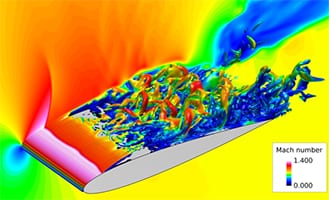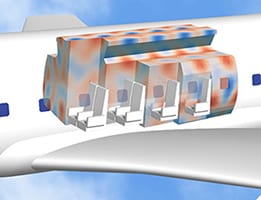We are steadily advancing fundamental numerical simulation technology and its peripheral technologies to meet the highest standards. Through this work, we aim to promote the practical application of numerical simulation technology and support projects within JAXA, as well as making greater contributions to the development and enhanced credibility of the aerospace field.

Simulation example of high speed buffet
on a 2D airfoil

Simulation example of aircraft cabin noise
Integrated simulation technologies
We are developing a system called the Integrated Simulation System of Aerospace vehiCles (ISSAC), which will enable broader applications of numerical simulation by combining the technical knowledge of various fields vital to aircraft development.
Combustion simulation technology
To enable the frontloading of aeroengine design through the use of numerical simulation technology, we are working to unravel and model the physical phenomena that occur inside aeroengine combustors and develop a simulation software of aeroengine combustors with the developed models.
FaSTAR-Move
We are developing a numerical simulation tool called FaSTAR-Move, an extended version of the fast unstructured-grid flow solver FaSTAR. By expanding the functionality of FaSTAR and combining several modules, FaSTAR-Move enables to conduct simulations in new areas.
Development of the world’s fastest high-efficiency CFD tool
We build user-friendly simulation tools that improve work efficiency in various simulation scenarios by enhancing the reliability of high-efficiency CFD tools (HexaGrid/FaSTAR), increasing usability by adding more functions, and improving operability through a graphical user interface (GUI).
Major simulation tools and softwares
Numerical simulation software
FaSTAR
A fast unstructured-grid fluid flow solver that achieved the world’s highest level of computation speed. Mainly computes aerodynamic forces (e.g., drag and lift) that act on aircraft and launch vehicles.
FaSTAR-Move
An enhanced version of FaSTAR that employs overset grid methods to analyze flow fields around moving and deforming objects. FaSTAR-Move can simulate the relative movement of an object caused by the force it receives from airflow.
BOXFUN (grid generation)
A large-scale parallel grid generation tool. Enables large-scale grid generation by combining the Building-Cube Method with the Cartesian grid generation framework, and improving the quality of grids by incorporating the user’s manual operation into capturing feature lines.
FBasis (mode decomposition)
A tool for extracting the characteristics of a flow field based on input CFD results. Spatiotemporal patterns hidden in the input data are automatically extracted using the proper orthogonal decomposition (POD) and dynamic mode decomposition (DMD) methods. Can be applied to three-dimensional unsteady flow fields and other large-scale data that are difficult to analyze with conventional methods. Supports FaSTAR and Plot3D data formats.
Optimization
Heuristic Algorithm for Real-World Multi-Objective Problem and Needs (Harmonee)
A toolset, or an aerodynamic optimization library, developed to enable the direct evolutionary computing for global optimization. According to the design problem at hand and the environment for solving it, an optimization method can be chosen: Harmonee-ea, which employs evolutionary algorithm for solving problems based on evaluation values obtained via direct simulation, or Harmonee-sa, which uses the approximate algorithm to reduce computation costs. Evolutionary computation is conducted using Non-dominated Sorting Genetic Algorithm-II (NSGA-II), a widely-used multi-objective evolutionary algorithm (MOEA), with additional algorithms developed and implemented to accommodate complex constraints. Compatible with FaSTAR.
Test data processing software
Flagship PSP data processing software
Data processing software for the steady pressure-sensitive paint (PSP) data reduction. The steady PSP measurement can acquire steady pressure distribution over a given PSP painting surface. The PSP luminescence is measured by a CCD or CMOS camera. The steady pressure distribution is computed from a camera data using an unstructured surface grid in consideration of practical use. Equipped with an automatic processing function of over 100 cases registered in advance in a database.
Unsteady PSP data processing software
Data processing software for the unsteady PSP data reduction. The unsteady PSP measurement can acquire unsteady pressure variations by using a fast-response PSP with more than 1 kHz dynamic response. The PSP luminescence is measured by a high-speed camera. The unsteady pressure distribution is computed from the high-speed camera data using an unstructured surface grid in consideration of practical use. Features a time-series pressure computation function, time-series movie production function, and frequency analysis function based on fast Fourier transform (FFT).
Noise source identification
Noise source identification analysis tool
A data processing tool for computing sound pressure distribution based on noise data measured using an array of numerous microphones (microphone array). Identifies the frequency characteristics and contribution of each sound source based on its location and sound pressure level.
March 30, 2020
Comments are closed.